Salamanders
Waterton Lakes National Park
There are two salamander species in Alberta, the long-toed salamander and the western tiger salamander, and both call Waterton Lakes home. Salamanders may be small, but they are not insignificant! They are top predators in their habitats. Salamanders can shape the ecosystem through their interconnections with plants, animals, and soil.
Long-toed salamander (Ambystoma macrodactylum)
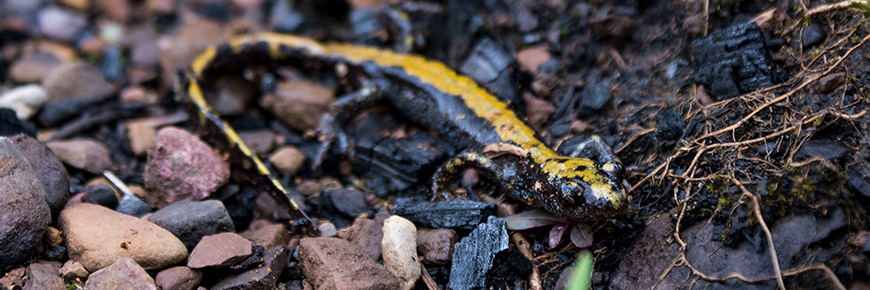
The long-toed salamander is an inconspicuous park resident. It is nocturnal and spends much of its time underground. The long-toed salamander has a black body and a district orange stripe down its back. The fourth toe on each hind foot is longer than the others, which inspired the salamanders’ descriptive name.
Long-toed salamanders lay their eggs in ponds and lakes in early spring. Aside from visiting water bodies for breeding, adults spend their lives on forest floors, foraging for insects in leaf litter, abandoned rodent dwellings and within tree root cavities.
The species is designated as Sensitive under the Alberta Wildlife Act.
A salamander saga: why did the salamander cross the road?
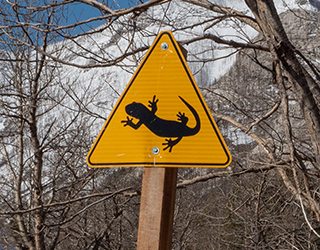
Have you seen this sign on your way into the Waterton community? This sign represents a special salamander conservation story in Waterton Lakes National Park.
On a rainy night in the spring of 1991, a park employee noticed something odd on the road approaching the Waterton community. He stopped and discovered salamanders - many salamanders! The salamanders were having difficulty climbing over a curb. The curb had recently been constructed as part of a road improvement project. This new curb was interrupting the salamanders’ breeding migration. Long-toed salamanders travel from the forests on the lower slopes of Crandell Mountain to Linnet Lake and back.
Helping the salamanders out became a community effort. Before changes could be made to the curb, local volunteers turned up to, literally, lend a hand. During two cool, rainy nights that April, volunteers lifted nearly 1200 salamanders over the curbs. Volunteers returned many other nights until permanent modifications were made in 1993. The adjusted grade of the curbs no longer posed a barrier to their movement, but vehicle traffic was still causing high rates of salamander roadway mortality.
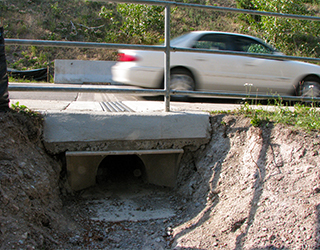
In 2001 temporary directional fences were installed near Linnet Lake, parallel to the entrance road. Salamanders following the fence would fall into specially-designed “traps” (yogurt containers dug into the ground). This kind of trap is safe and often used for amphibians. Moist sponges were placed at the bottom of the containers and wooden covers protected the animals. Staff checked the traps daily to carry the salamanders across the road.
Permanent directional fences and tunnels were installed in 2008 to provide safe passage. The tunnels have slots that allow air, moisture and light inside, creating a suitable environment for animals to travel through. This was the first time an amphibian road crossing was installed in a Parks Canada-administered place. This crossing system has inspired many other parks and organizations to follow suit.
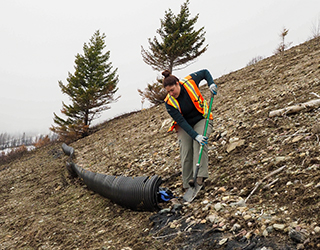
Research completed before and after the tunnel installation has shown them to be effective. It has reduced the salamander's roadway mortality rate. The tunnels are also used by other species - western tiger salamanders, western toads, Columbian ground squirrels, and wandering garter snakes.
The 2017 Kenow Wildfire destroyed the plastic fences. Without the fences, salamanders were once again susceptible to harm on the road. Parks Canada staff and volunteers came together to clean up the burned fencing. Temporary fencing was installed and planning was underway to rebuild the permanent fences.
In fall 2018, approximately 750 metres of salvaged guardrail material from Red Rock and Akamina Parkways was installed as permanent directional fencing. Reusing the damaged guardrail was not only a cost-saving measure. It created a more permanent structure than the previous plastic fences.
Through innovative approaches and collaborations, Parks Canada continues to care for the long-toed salamanders of Linnet Lake.
Read more about the salamander fencing repair following the Kenow Wildfire.Western tiger salamander (Prairie / Boreal Population) (Ambystoma mavortium)
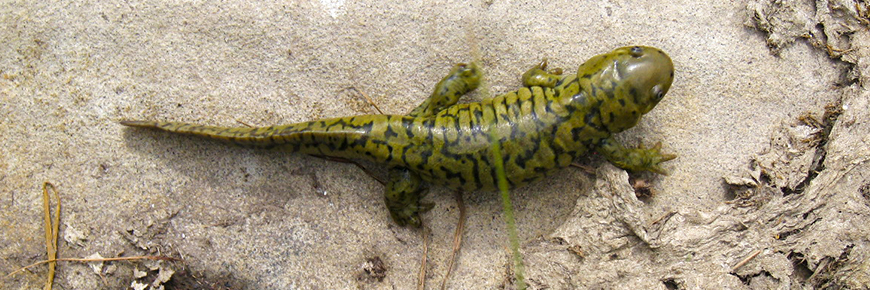
The western tiger salamander belongs to the mole salamander family. It certainly lives up to this family name, as it spends a lot of time underground. If you are lucky, you may come across one here in Waterton Lakes National Park. Early mornings after rainy nights in the spring or early fall are the best times to spot this species of salamanders, usually near wetlands and small bodies of water. In prairie habitats, western tiger salamanders forage for invertebrates after dark.
These salamanders are one of the largest salamander species in North America. They may reach 20 centimetres or more in adulthood. Their colouration may resemble a tiger, with an alternating pattern of light yellow (or off-white) and dark stripes. This colouration is variable, and can range in appearance from blotchy to spotted.
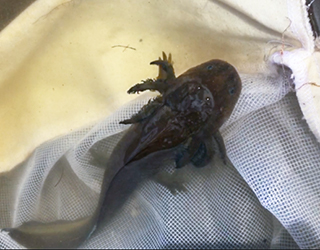
In springtime, the western tiger salamander lays egg masses on underwater vegetation. When the environment in water is more favorable than out, the western tiger salamander can delay metamorphosis from larva to adult. In some areas, adult western tiger salamanders may keep their juvenile features through a process called neoteny.
The western tiger salamander is designated as a Species of Special Concern under Canada’s Species at Risk Act.
In 2011, a western tiger salamander population in Waterton Lakes National Park was affected by the Ambystoma tigrinum virus (ATV). ATV is an aquatic disease and part of the ranavirus family. These are infectious diseases that can affect amphibians, reptiles and fish. ATV can have a significant impact on local salamander populations, with 40-90% mortality in some areas.
This virus may be spread through water or sediment moving from one location to another, or by infected salamanders. Parks Canada aquatic scientists, partners and volunteers follow a strict decontamination protocol (Clean, Drain, Dry) to minimize the spread of any aquatic disease.
Help us stop the spread of aquatic invasive species and diseases. You can help protect tiger salamanders from ATV by always practicing Clean, Drain, Dry with your own watercraft and gear. In Waterton Lakes National Park, it is mandatory to have your watercraft inspected or to complete a mandatory self-certification for your equipment. Make sure your fishing gear, watercraft and all equipment is dry before launching in any body of water.
Related links
- Date modified :